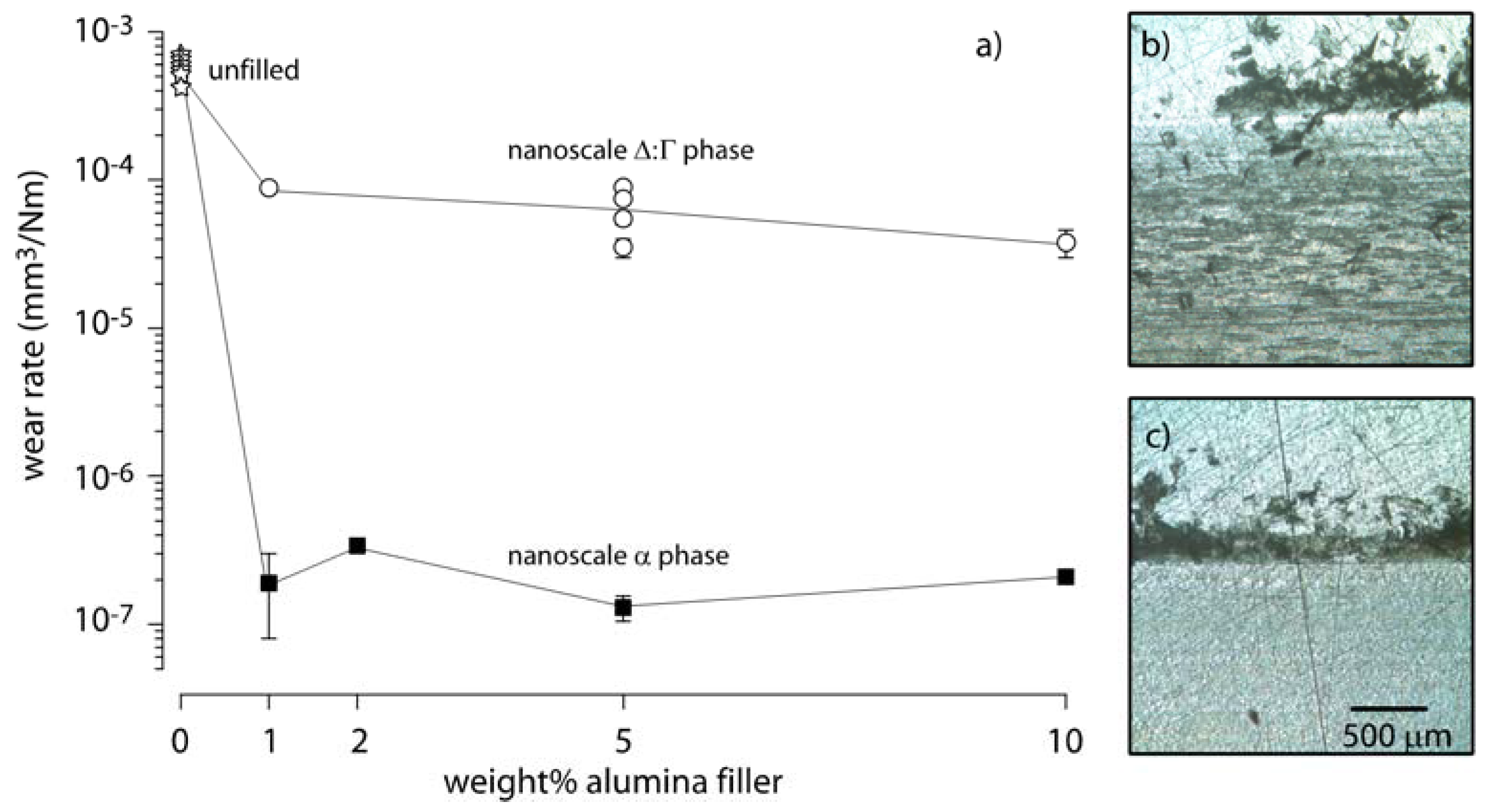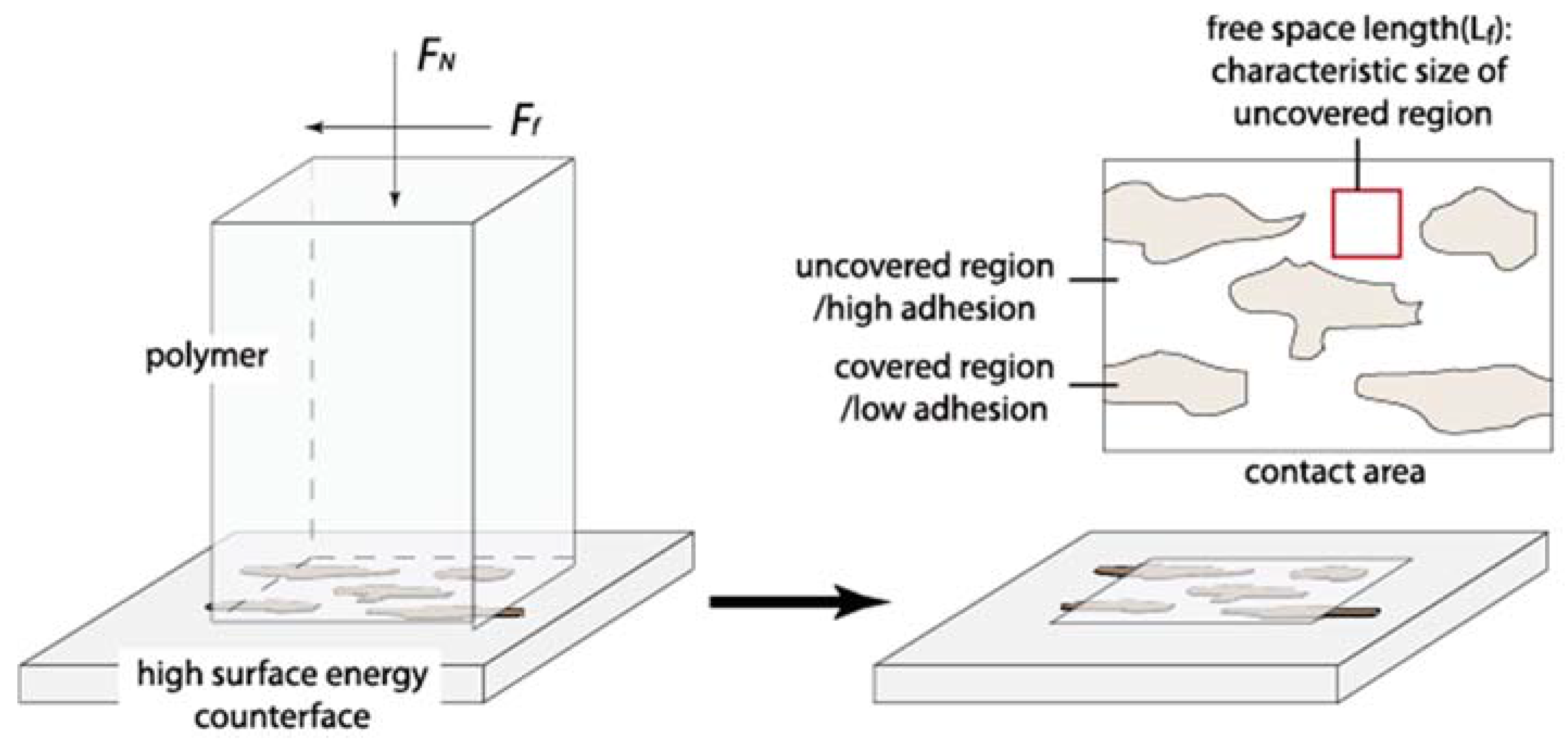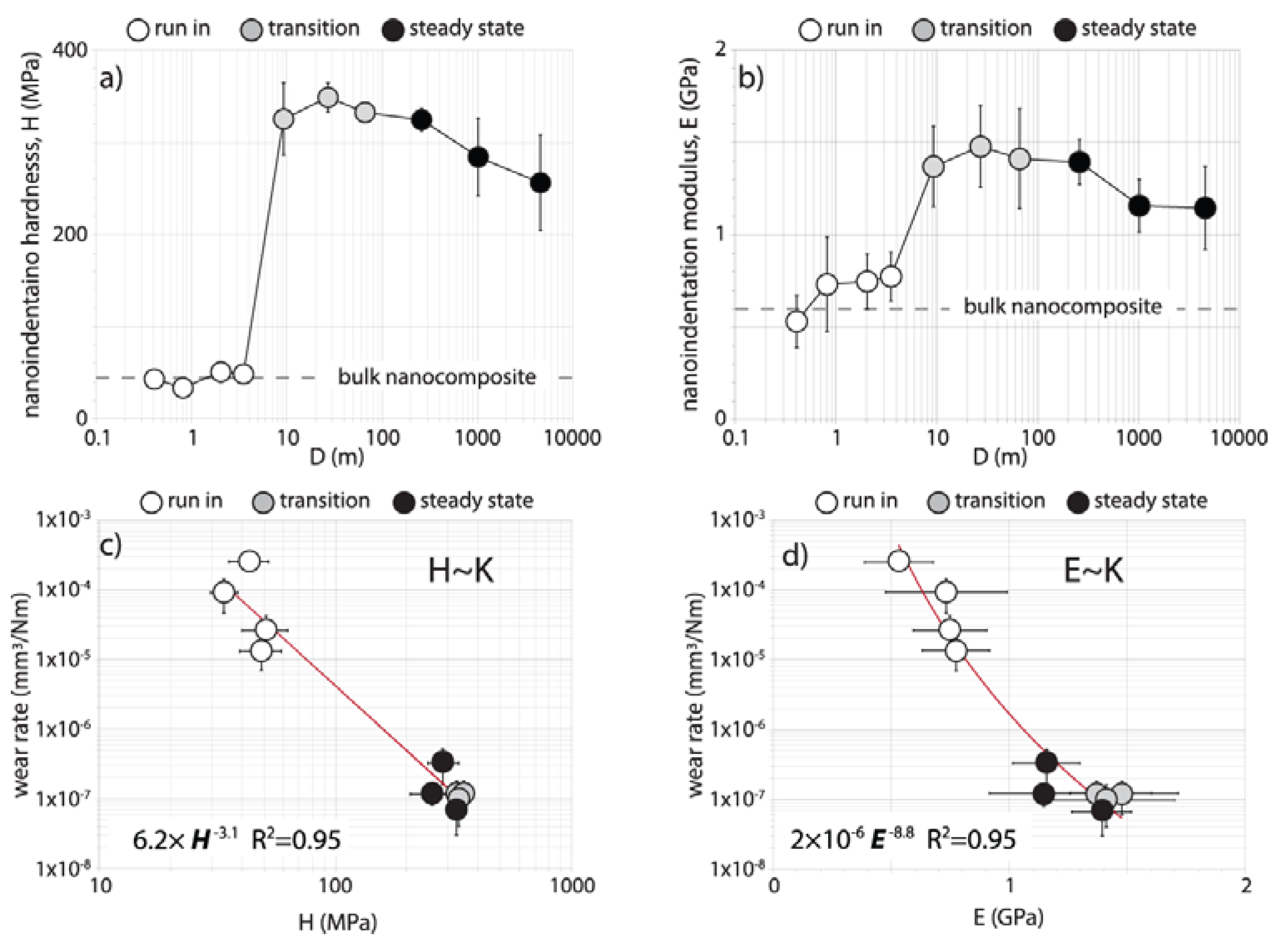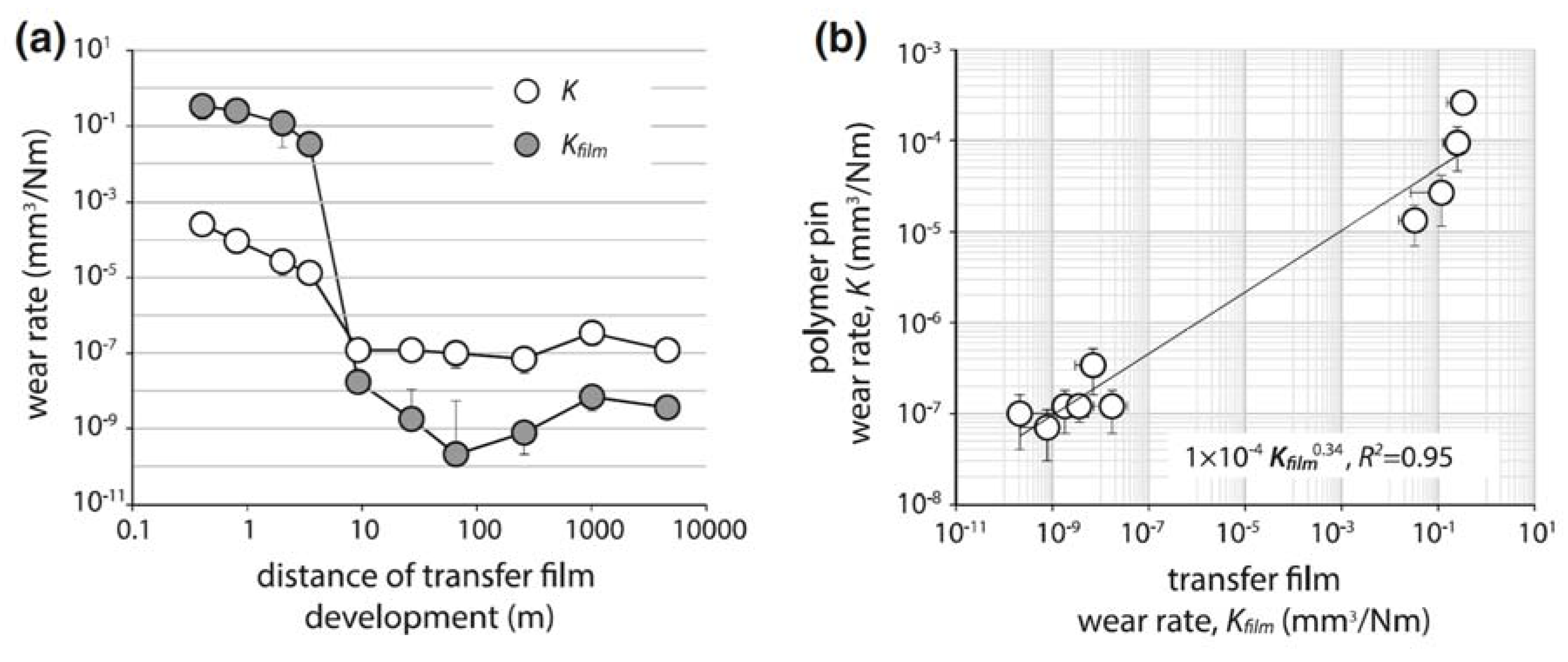A Review of Transfer Films and Their Role in Ultra-Low-Wear Sliding of Polymers
Abstract
:1. Introduction
2. Transfer Films and Their Link to Low Wear
3. The Effects of Filler Characteristics on Transfer Films and Wear Rates
4. Quantifying Properties of Transfer Films
4.1. Transfer Film Morphology
4.2. Chemistry of the Transfer Film
4.3. Mechanical Properties of the Transfer Film
4.4. Adhesion of the Transfer Film
5. Summary
Acknowledgments
Author Contributions
Conflicts of Interest
References
- Friedrich, K.; Malzahn, J.C. Abrasive wear and fracture properties of short fiber/thermoplastic matrix composites. In Wear of Materials; ASME: New York, NY, USA, 1983; pp. 604–609. [Google Scholar]
- Evans, D.C. The influence of abrasive fillers on the wear properties of polytetrafluoroethylene(PTFE)-based composites. In ASLE Proceedings—2nd International Conference on Solid Lubrication, Denver, CO, USA, 15–18 August 1978.
- Bahadur, S.; Gong, D. The action of fillers in the modification of the tribological behavior of polymers. Wear 1992, 158, 41–59. [Google Scholar] [CrossRef]
- Makinson, K.R.; Tabor, D. Friction and transfer of polytetrafluoroethylene. Nature 1964, 201, 464–466. [Google Scholar] [CrossRef]
- Pooley, C.M.; Tabor, D. Transfer of PTFE and related polymers in a sliding experiment. Nature 1972, 237, 88–90. [Google Scholar] [CrossRef]
- Blanchet, T.A.; Kennedy, F.E. Sliding wear mechanism of polytetrafluoroethylene (PTFE) and PTFE composites. Wear 1992, 153, 229–243. [Google Scholar] [CrossRef]
- Lancaster, J.K. Polymer-based bearing materials: The role of fillers and fibre reinforcement. Tribology 1972, 5, 249–255. [Google Scholar] [CrossRef]
- Briscoe, B. Wear of polymers: An essay on fundamental aspects. Tribol. Int. 1981, 14, 231–243. [Google Scholar] [CrossRef]
- Bahadur, S.; Tabor, D. The wear of filled polytetrafluoroethylene. Wear 1984, 98, 1–13. [Google Scholar] [CrossRef]
- Bahadur, S.; Gong, D.; Anderegg, J.W. The role of copper compounds as fillers in transfer film formation and wear of nylon. Wear 1992, 154, 207–223. [Google Scholar] [CrossRef]
- Burroughs, B.R.; Kim, J.-H.; Blanchet, T.A. Boric acid self-lubrication of b2o3-filled polymer composites. Tribol. Trans. 1999, 42, 592–600. [Google Scholar] [CrossRef]
- Blanchet, T.A. A model for polymer composite wear behavior including preferential load support and surface accumulation of filler particulates. Tribol. Trans. 1995, 38, 821–828. [Google Scholar] [CrossRef]
- Burris, D.L.; Sawyer, W.G. Tribological sensitivity of PTFE/alumina nanocomposites to a range of traditional surface finishes. Tribol. Trans. 2005, 48, 147–153. [Google Scholar] [CrossRef]
- Tanaka, K.; Kawakami, S. Effect of various fillers on the friction and wear of polytetrafluoroethylene-based composites. Wear 1982, 79, 221–234. [Google Scholar] [CrossRef]
- Li, F.; Hu, K.-A.; Li, J.-A.; Zhao, B.-Y. The friction and wear characteristics of nanometer zno filled polytetrafluoroethylene. Wear 2001, 249, 877–882. [Google Scholar] [CrossRef]
- Chen, W.X.; Li, F.; Han, G.; Xia, J.B.; Wang, L.Y.; Tu, J.P.; Xu, Z.D. Tribological behavior of carbon-nanotube-filled PTFE composites. Tribol. Lett. 2003, 15, 275–278. [Google Scholar] [CrossRef]
- Sawyer, W.G.; Freudenberg, K.D.; Bhimaraj, P.; Schadler, L.S. A study on the friction and wear behavior of PTFE filled with alumina nanoparticles. Wear 2003, 254, 573–580. [Google Scholar] [CrossRef]
- Burris, D.L.; Sawyer, W.G. Improved wear resistance in alumina-PTFE nanocomposites with irregular shaped nanoparticles. Wear 2006, 260, 915–918. [Google Scholar] [CrossRef]
- Burris, D.L.; Zhao, S.; Duncan, R.; Lowitz, J.; Perry, S.S.; Schadler, L.S.; Sawyer, W.G. A route to wear resistant PTFE via trace loadings of functionalized nanofillers. Wear 2009, 267, 653–660. [Google Scholar] [CrossRef]
- Ye, J.; Khare, H.S.; Burris, D.L. Transfer film evolution and its role in promoting ultra-low wear of a PTFE nanocomposite. Wear 2013, 297, 1095–1102. [Google Scholar] [CrossRef]
- Ye, J.; Khare, H.S.; Burris, D.L. Quantitative characterization of solid lubricant transfer film quality. Wear 2014, 316, 133–143. [Google Scholar] [CrossRef]
- Ye, J.; Moore, A.C.; Burris, D.L. Transfer film tenacity: A case study using ultra-low-wear alumina–PTFE. Tribol. Lett. 2015, 59, 1–11. [Google Scholar] [CrossRef]
- Krick, B.A.; Ewin, J.J.; Blackman, G.S.; Junk, C.P.; Gregory Sawyer, W. Environmental dependence of ultra-low wear behavior of polytetrafluoroethylene (PTFE) and alumina composites suggests tribochemical mechanisms. Tribol. Int. 2012, 51, 42–46. [Google Scholar] [CrossRef]
- Krick, B.A.; Ewin, J.J.; McCumiskey, E.J. Tribofilm formation and run-in behavior in ultra-low-wearing polytetrafluoroethylene (PTFE) and alumina nanocomposites. Tribol. Trans. 2014, 57, 1058–1065. [Google Scholar] [CrossRef]
- Pitenis, A.A.; Ewin, J.J.; Harris, K.L.; Sawyer, W.G.; Krick, B.A. In vacuo tribological behavior of polytetrafluoroethylene (PTFE) and alumina nanocomposites: The importance of water for ultralow wear. Tribol. Lett. 2014, 53, 189–197. [Google Scholar] [CrossRef]
- Sawyer, W.G.; Argibay, N.; Burris, D.L.; Krick, B.A. Mechanistic studies in friction and wear of bulk materials. Annu. Rev. Mater. Res. 2014, 44, 395–427. [Google Scholar] [CrossRef]
- Harris, K.L.; Pitenis, A.A.; Sawyer, W.G.; Krick, B.A.; Blackman, G.S.; Kasprzak, D.J.; Junk, C.P. PTFE tribology and the role of mechanochemistry in the development of protective surface films. Macromolecules 2015, 48, 3739–3745. [Google Scholar] [CrossRef]
- Harris, K.L.; Curry, J.F.; Pitenis, A.A.; Rowe, K.G.; Sidebottom, M.A.; Sawyer, W.G.; Krick, B.A. Wear debris mobility, aligned surface roughness, and the low wear behavior of filled polytetrafluoroethylene. Tribol. Lett. 2015, 60, 1–8. [Google Scholar]
- Pitenis, A.A.; Harris, K.L.; Junk, C.P.; Blackman, G.S.; Sawyer, W.G.; Krick, B.A. Ultralow wear PTFE and alumina composites: It is all about tribochemistry. Tribol. Lett. 2015, 57. [Google Scholar] [CrossRef]
- Krick, B.A.; Pitenis, A.A.; Harris, K.L.; Junk, C.P.; Sawyer, W.G.; Brown, S.C.; Rosenfeld, H.D.; Kasprzak, D.J.; Johnson, R.S.; Chan, C.D.; et al. Ultralow wear fluoropolymer composites: Nanoscale functionality from microscale fillers. Tribol. Int. 2016, 95, 245–255. [Google Scholar] [CrossRef]
- McElwain, S.E.; Blanchet, T.A.; Schadler, L.S.; Sawyer, W.G. Effect of particle size on the wear resistance of alumina-filled PTFE micro- and nanocomposites. Tribol. Trans. 2008, 51, 247–253. [Google Scholar] [CrossRef]
- Blanchet, T.A.; Kandanur, S.S.; Schadler, L.S. Coupled effect of filler content and countersurface roughness on PTFE nanocomposite wear resistance. Tribol. Lett. 2009, 40, 11–21. [Google Scholar] [CrossRef]
- Kandanur, S.S. The Role of Filler Size & Content and Countersurface Roughness in the Wear Resistance of Alumina-PTFE Nano-Composites. Ph.D. Thesis, Rensselaer Polytechnic Institute, New York, NY, USA, 2010. [Google Scholar]
- Kandanur, S.S.; Schrameyer, M.A.; Jung, K.F.; Makowiec, M.E.; Bhargava, S.; Blanchet, T.A. Effect of activated carbon and various other nanoparticle fillers on PTFE wear. Tribol. Trans. 2014, 57, 821–830. [Google Scholar] [CrossRef]
- Kandanur, S.S.; Rafiee, M.A.; Yavari, F.; Schrameyer, M.; Yu, Z.-Z.; Blanchet, T.A.; Koratkar, N. Suppression of wear in graphene polymer composites. Carbon 2012, 50, 3178–3183. [Google Scholar] [CrossRef]
- Schwartz, C.J.; Bahadur, S. Studies on the tribological behavior and transfer film–counterface bond strength for polyphenylene sulfide filled with nanoscale alumina particles. Wear 2000, 237, 261–273. [Google Scholar] [CrossRef]
- Burris, D.L.; Boesl, B.; Bourne, G.R.; Sawyer, W.G. Polymeric nanocomposites for tribological applications. Macromol. Mater. Eng. 2007, 292, 387–402. [Google Scholar] [CrossRef]
- Burris, D.L. Wear-Resistance Mechanisms in Polytetrafluoroethylene (PTFE) Based Tribological Nanocomposites; University of Florida: Gainesville, FL, USA, 2006. [Google Scholar]
- Khare, H.S.; Moore, A.C.; Haidar, D.R.; Gong, L.; Ye, J.; Rabolt, J.F.; Burris, D.L. Interrelated effects of temperature and environment on wear and tribochemistry of an ultralow wear PTFE composite. J. Phys. Chem. C 2015, 119, 16518–16527. [Google Scholar] [CrossRef]
- Laux, K.A.; Schwartz, C.J. Effects of contact pressure, molecular weight, and supplier on the wear behavior and transfer film of polyetheretherketone (peek). Wear 2013, 297, 919–925. [Google Scholar] [CrossRef]
- Bhimaraj, P.; Burris, D.; Sawyer, W.G.; Toney, C.G.; Siegel, R.W.; Schadler, L.S. Tribological investigation of the effects of particle size, loading and crystallinity on poly (ethylene) terephthalate nanocomposites. Wear 2008, 264, 632–637. [Google Scholar] [CrossRef]
- Ye, J. Characterizing PTFE Transfer Film Properties to Elucidate Transfer Film’s Role in Ultra-Low Wear Sliding of Polymer Nanocomposites. Ph.D. Thesis, University of Delaware, Newark, DE, USA, 2014. [Google Scholar]
- Rabinowicz, E. Friction and Wear of Materials; Wiley: New York, NY, USA, 1995. [Google Scholar]
- Blanchet, T.A.; Kennedy, F.E.; Jayne, D.T. Xps analysis of the effect of fillers on PTFE transfer film development in sliding contacts. Tribol. Trans. 1993, 36, 535–544. [Google Scholar] [CrossRef]
- Jintang, G. Tribochemical effects in formation of polymer transfer film. Wear 2000, 245, 100–106. [Google Scholar] [CrossRef]
- Burris, D.L.; Santos, K.; Lewis, S.L.; Liu, X.; Perry, S.S.; Blanchet, T.A.; Schadler, L.S.; Sawyer, W.G. Polytetrafluoroethylene matrix nanocomposites for tribological applications. Tribol. Polym. Nanocompos. 2008, 55, 403–438. [Google Scholar]
- Onodera, T.; Kawasaki, K.; Nakakawaji, T.; Higuchi, Y.; Ozawa, N.; Kurihara, K.; Kubo, M. Chemical reaction mechanism of polytetrafluoroethylene on aluminum surface under friction condition. J. Phys. Chem. C 2014, 118, 5390–5396. [Google Scholar] [CrossRef]
- Onodera, T.; Kawasaki, K.; Nakakawaji, T.; Higuchi, Y.; Ozawa, N.; Kurihara, K.; Kubo, M. Effect of tribochemical reaction on transfer-film formation by poly (tetrafluoroethylene). J. Phys. Chem. C 2014, 118, 11820–11826. [Google Scholar] [CrossRef]
- Li, H.; Yin, Z.; Jiang, D.; Jin, L.; Cui, Y. A study of the tribological behavior of transfer films of PTFE composites formed under different loads, speeds and morphologies of the counterface. Wear 2015, 328–329, 17–27. [Google Scholar] [CrossRef]
- Xie, T.; Yang, H.; Xu, Z.X.; Yang, H.P.; Cui, A.L. Influence of steel surface texture direction on the formation of friction transfer film of sio2/PTFE composites. J. Hefei Univ. Technol. 2014, 37, 513–515. [Google Scholar]
- Deli, G.; Qunji, X.; Hongli, W. Physical models of adhesive wear of polytetrafluoroethylene and its composites. Wear 1991, 147, 9–24. [Google Scholar] [CrossRef]
- Friedrich, K.; Flöck, J.; Váradi, K.; Néder, Z. Experimental and numerical evaluation of the mechanical properties of compacted wear debris layers formed between composite and steel surfaces in sliding contact. Wear 2001, 251, 1202–1212. [Google Scholar] [CrossRef]
- Chang, L.; Zhang, Z.; Ye, L.; Friedrich, K. Tribological properties of epoxy nanocomposites: Iii. Characteristics of transfer films. Wear 2007, 262, 699–706. [Google Scholar] [CrossRef]
- Randall, N.X.; Bozet, J.L. Nanoindentation and scanning force microscopy as a novel method for the characterization of tribological transfer films. Wear 1997, 212, 18–24. [Google Scholar] [CrossRef]
- Randall, N.X.; Harris, A. Nanoindentation as a tool for characterising the mechanical properties of tribological transfer films. Wear 2000, 245, 196–203. [Google Scholar] [CrossRef]
- McCook, N.L.; Burris, D.L.; Bourne, G.R.; Steffens, J.; Hanrahan, J.R.; Sawyer, W.G. Wear resistant solid lubricant coating made from PTFE and epoxy. Tribol. Lett. 2005, 18, 119–124. [Google Scholar] [CrossRef]
- Xie, T.; Zhou, Z.H.; Xu, Z.X.; Yu, J.W.; Jiao, M.H. Characteristics of the Transfer Film and Tribological Properties of Oxide/PTFE Composites; Trans Tech Publications Inc.: Pfaffikon, Switzerland, 2013; pp. 172–175. [Google Scholar]
- Xu, Z.X. Performances of Different Fillers in Polymer Composites during Frictional Transfer; University of Technology: Hefei, China, 2012. [Google Scholar]
- Bahadur, S. The development of transfer layers and their role in polymer tribology. Wear 2000, 245, 92–99. [Google Scholar] [CrossRef]
- Bahadur, S.; Sunkara, C. Effect of transfer film structure, composition and bonding on the tribological behavior of polyphenylene sulfide filled with nano particles of tio2, zno, cuo and sic. Wear 2005, 258, 1411–1421. [Google Scholar] [CrossRef]
- Xie, T.; Zhou, Z.H.; Xu, Z.X.; Yu, J.W.; Jiao, M.H. Characteristics of the transfer film and tribological properties of oxide/PTFE composites. Adv. Mater. Res. 2013, 631–632, 172–175. [Google Scholar] [CrossRef]
- Xie, T.; Wan, Y.Y.; Miao, P.; Wen, D.D.; Jiao, M.H.; Yu, J.W.; Yin, Y.G. Dynamic transfer of PTFE three-layer composite materials during friction. Lubr. Eng. 2010, 2, 3. [Google Scholar]
- Buckley, D.H.; Johnson, R.L. Friction, Wear, and Decomposition Mechanisms for Various Polymer Compositions in Vacuum to 10–9 Millimeter of Mercury; National Aeronautics and Space Administration: Washington, DC, USA, 1963; Volume 2073. [Google Scholar]
- Pocock, G.; Cadman, P. The application of differential scanning calorimetry and electron spectroscopy to PTFE-metal reactions of interest in dry bearing technology. Wear 1976, 37, 129–141. [Google Scholar] [CrossRef]
- Cadman, P.; Gossedge, G.M. The chemical nature of metal-polytetrafluoroethylene tribological interactions as studied by x-ray photoelectron spectroscopy. Wear 1979, 54, 211–215. [Google Scholar] [CrossRef]
- Jintang, G.; Hongxin, D. Molecule structure variations in friction of stainless steel/PTFE and its composite. J. Appl. Polym. Sci. 1988, 36, 73–85. [Google Scholar] [CrossRef]
- Deli, G.; Qunji, X.; Hongli, W. Esca study on tribochemical characteristics of filled PTFE. Wear 1991, 148, 161–169. [Google Scholar] [CrossRef]
- Agrawal, D.C.; Raj, R. Measurement of the ultimate shear strength of a metal-ceramic interface. Acta Metall. 1989, 37, 1265–1270. [Google Scholar] [CrossRef]
- Agrawal, D.C.; Raj, R. Ultimate shear strengths of copper-silica and nickel-silica interfaces. Mater. Sci. Eng. A 1990, 126, 125–131. [Google Scholar] [CrossRef]
- Wang, Y.; Yan, F. Tribological properties of transfer films of PTFE-based composites. Wear 2006, 261, 1359–1366. [Google Scholar] [CrossRef]
- Wang, Y.; Yan, F. A study on tribological behaviour of transfer films of PTFE/bronze composites. Wear 2007, 262, 876–882. [Google Scholar] [CrossRef]
- Wang, Y.; Wang, H.; Yan, F. Investigation of transfer film of PTFE/bronze composites on 2024al surface. Surf. Interface Anal. 2009, 41, 753–758. [Google Scholar] [CrossRef]
- Urueña, J.M.; Pitenis, A.A.; Harris, K.L.; Sawyer, W.G. Evolution and wear of fluoropolymer transfer films. Tribol. Lett. 2015, 57. [Google Scholar] [CrossRef]










© 2016 by the authors; licensee MDPI, Basel, Switzerland. This article is an open access article distributed under the terms and conditions of the Creative Commons by Attribution (CC-BY) license (http://creativecommons.org/licenses/by/4.0/).
Share and Cite
Ye, J.; Burris, D.L.; Xie, T. A Review of Transfer Films and Their Role in Ultra-Low-Wear Sliding of Polymers. Lubricants 2016, 4, 4. https://doi.org/10.3390/lubricants4010004
Ye J, Burris DL, Xie T. A Review of Transfer Films and Their Role in Ultra-Low-Wear Sliding of Polymers. Lubricants. 2016; 4(1):4. https://doi.org/10.3390/lubricants4010004
Chicago/Turabian StyleYe, Jiaxin, David L. Burris, and Ting Xie. 2016. "A Review of Transfer Films and Their Role in Ultra-Low-Wear Sliding of Polymers" Lubricants 4, no. 1: 4. https://doi.org/10.3390/lubricants4010004




